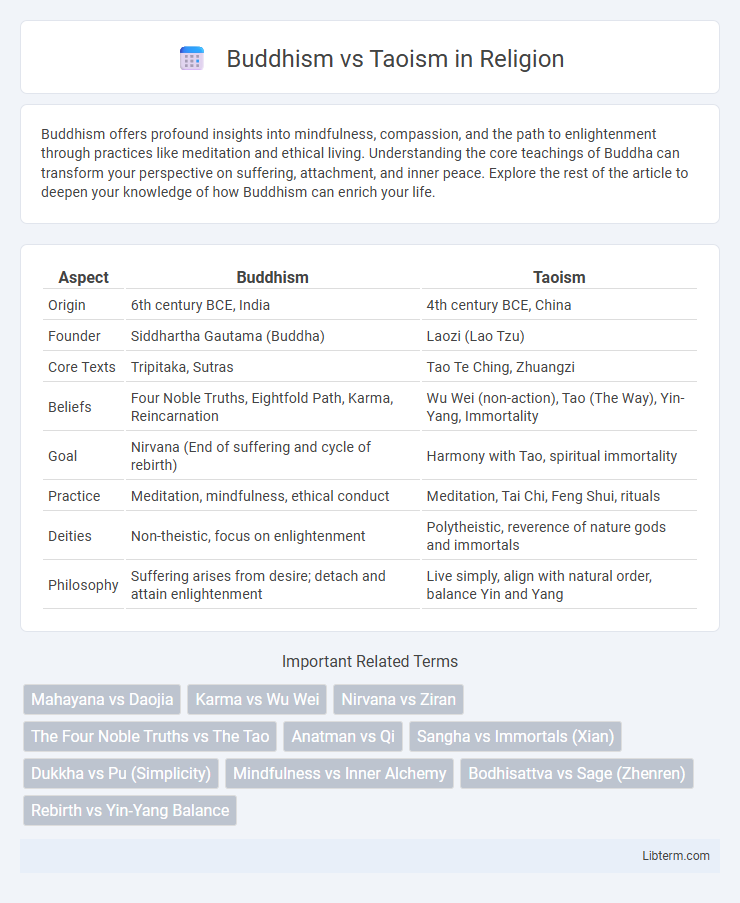Buddhism offers profound insights into mindfulness, compassion, and the path to enlightenment through practices like meditation and ethical living. Understanding the core teachings of Buddha can transform your perspective on suffering, attachment, and inner peace. Explore the rest of the article to deepen your knowledge of how Buddhism can enrich your life.
Table of Comparison
| Aspect | Buddhism | Taoism |
|---|---|---|
| Origin | 6th century BCE, India | 4th century BCE, China |
| Founder | Siddhartha Gautama (Buddha) | Laozi (Lao Tzu) |
| Core Texts | Tripitaka, Sutras | Tao Te Ching, Zhuangzi |
| Beliefs | Four Noble Truths, Eightfold Path, Karma, Reincarnation | Wu Wei (non-action), Tao (The Way), Yin-Yang, Immortality |
| Goal | Nirvana (End of suffering and cycle of rebirth) | Harmony with Tao, spiritual immortality |
| Practice | Meditation, mindfulness, ethical conduct | Meditation, Tai Chi, Feng Shui, rituals |
| Deities | Non-theistic, focus on enlightenment | Polytheistic, reverence of nature gods and immortals |
| Philosophy | Suffering arises from desire; detach and attain enlightenment | Live simply, align with natural order, balance Yin and Yang |
Introduction to Buddhism and Taoism
Buddhism centers on the teachings of Siddhartha Gautama, emphasizing the Four Noble Truths and the Eightfold Path as a guide to overcoming suffering and achieving Nirvana. Taoism, attributed to Laozi and the foundational text Tao Te Ching, focuses on living in harmony with the Tao, or the natural way, promoting simplicity, spontaneity, and balance. Both traditions influence East Asian spirituality but differ in their approach to life's purpose and the nature of the self.
Historical Origins and Development
Buddhism originated in the 6th century BCE in Northern India, founded by Siddhartha Gautama, known as the Buddha, emphasizing the Four Noble Truths and the Eightfold Path as a means to attain enlightenment. Taoism, emerging around the 4th century BCE in ancient China, is attributed to Laozi and centers on living harmoniously with the Tao, or the fundamental force underlying the universe. Both philosophies developed distinct practices and doctrines, with Buddhism spreading across Asia through monastic traditions and Taoism influencing Chinese culture, religion, and political thought through texts like the Tao Te Ching.
Core Philosophical Beliefs
Buddhism centers on the Four Noble Truths and the Eightfold Path, emphasizing the cessation of suffering through mindfulness, ethical conduct, and meditation to achieve enlightenment (nirvana). Taoism prioritizes living in harmony with the Tao, the fundamental principle underlying the universe, encouraging simplicity, spontaneity, and wu wei (non-action or effortless action). Both philosophies explore the nature of existence and the path to spiritual fulfillment but diverge in their approaches to ultimate reality and practice.
Key Texts and Scriptures
The key texts of Buddhism include the Tripitaka, Mahayana Sutras, and Tibetan Book of the Dead, which provide teachings on the Four Noble Truths, the Eightfold Path, and enlightenment. Taoism's foundational scriptures are the Tao Te Ching by Laozi and the Zhuangzi, emphasizing harmony with the Tao, naturalness, and simplicity. Both traditions utilize their texts to guide spiritual practice, ethical living, and understanding of the universe's fundamental nature.
Concepts of the Ultimate Reality
Buddhism defines the Ultimate Reality as Nirvana, a transcendent state free from suffering and individual existence, achieved through the cessation of desire and attachment. Taoism centers on the Tao, an ineffable and harmonious principle underlying the universe, representing the natural order and the source of all being. Both philosophies emphasize experiential understanding over intellectual analysis to connect with these ultimate truths.
Practices and Rituals
Buddhist practices center on meditation, chanting, and mindfulness aimed at achieving enlightenment and overcoming suffering, often including rituals like offerings at stupas and monastic ceremonies. Taoism emphasizes harmony with the Tao through rituals involving tai chi, qigong, and feng shui, as well as ceremonies honoring deities and nature spirits to balance spiritual energy (qi). Both traditions use symbolic gestures and sacred texts, but Buddhism prioritizes the Eightfold Path and monastic discipline, whereas Taoism focuses on naturalness and simplicity aligned with the flow of the universe.
Perspective on Suffering and Happiness
Buddhism teaches that suffering (dukkha) arises from attachment and desire, and achieving enlightenment through the Eightfold Path leads to the cessation of suffering and true happiness (nirvana). Taoism views suffering as a consequence of resisting the natural flow of life (Tao) and promotes living in harmony with nature to attain contentment and balance. Both philosophies emphasize inner transformation but differ in their approach: Buddhism focuses on overcoming internal cravings, while Taoism prioritizes alignment with the universe's effortless way.
Approaches to Morality and Ethics
Buddhism emphasizes the Eightfold Path and the Five Precepts as core ethical guidelines aimed at reducing suffering through mindfulness, compassion, and non-harming behavior. Taoism, centered on the Tao Te Ching and natural harmony, advocates for spontaneous, effortless action (wu wei) and alignment with the natural order rather than rigid moral codes. Both traditions encourage ethical living but differ in that Buddhism provides explicit moral rules, while Taoism promotes an intuitive, flexible approach rooted in balance and flow.
Influence on Culture and Society
Buddhism profoundly shapes cultural practices through meditation, ethical living, and rituals promoting compassion and mindfulness, impacting art, literature, and social values across Asia. Taoism emphasizes harmony with nature, influencing Chinese medicine, calligraphy, and festivals that celebrate balance and natural order. Both traditions foster community cohesion and moral frameworks, deeply embedding spiritual principles into societal norms and cultural identities.
Modern Relevance and Global Presence
Buddhism, with over 500 million adherents worldwide, influences modern wellness practices such as mindfulness meditation and stress reduction techniques prevalent in Western healthcare. Taoism, though smaller in global followers, significantly shapes contemporary environmental ethics and holistic health approaches rooted in harmony with nature. Both religions contribute to global spiritual discourse, promoting inner peace and ecological balance in an increasingly interconnected world.
Buddhism Infographic

 libterm.com
libterm.com